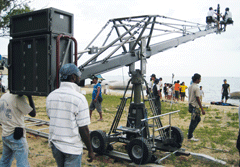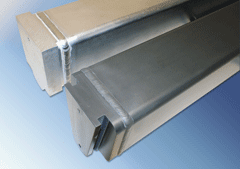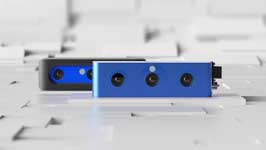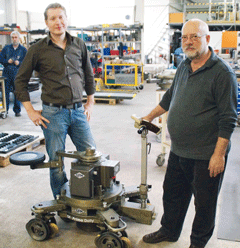Wear-resistant surfaces on camera equipment
- Details
- Hits: 11095
 As was common in the industry at the beginning, aluminum components were previously powder coated black. After a short time in use, the parts returned for maintenance showed clear signs of wear. They no longer looked like new. Inspired by a consultation with an AHC sales representative, Antonio Tundo decided to take a new path for the Grip Factory products and have the aluminum parts of his camera equipment hard-anodized using the "hard coat" process.
As was common in the industry at the beginning, aluminum components were previously powder coated black. After a short time in use, the parts returned for maintenance showed clear signs of wear. They no longer looked like new. Inspired by a consultation with an AHC sales representative, Antonio Tundo decided to take a new path for the Grip Factory products and have the aluminum parts of his camera equipment hard-anodized using the "hard coat" process.
 This is an electrolytic method of the AHC surface GmbH in which the workpieces to be coated are connected as the anode and immersed in an acidic electrolyte at a relatively low temperature. With the aid of electric current, a protective aluminum oxide layer is produced on the workpiece surface, the thickness of which is adjustable, and is for most applications and in the range between 30 60 microns. The color scheme of a hard coat layer is influenced by the film thickness, the base material used and its structure. The aluminum alloys used by the Grip Factory Munich GmbH, the hard-anodizing layer usually has an olive-green color. The clientele initially reacted skeptically to the Military color ', but could be convinced of the quality of the layer. Together with the engraved lettering Grip Factory Munich the olive-green color of the equipment parts has long since a trademark.
This is an electrolytic method of the AHC surface GmbH in which the workpieces to be coated are connected as the anode and immersed in an acidic electrolyte at a relatively low temperature. With the aid of electric current, a protective aluminum oxide layer is produced on the workpiece surface, the thickness of which is adjustable, and is for most applications and in the range between 30 60 microns. The color scheme of a hard coat layer is influenced by the film thickness, the base material used and its structure. The aluminum alloys used by the Grip Factory Munich GmbH, the hard-anodizing layer usually has an olive-green color. The clientele initially reacted skeptically to the Military color ', but could be convinced of the quality of the layer. Together with the engraved lettering Grip Factory Munich the olive-green color of the equipment parts has long since a trademark.
Shades disappear
However, one wish still remains unfulfilled, namely that of a homogeneous color of the hard-anodised parts that always looks the same. Even with the same aluminum alloy, the color can vary from coating batch to coating batch. This depends on the alloy distribution, the layer thickness tolerances and the electrolyte temperature. Deviations in the electrolyte composition also contribute to changes in color. The AHC plant in Munich, in which the parts for Grip Factory are coated, has long since reacted to these findings in terms of system technology: All hard-coat tanks are fed from the same electrolyte. This at least minimizes the color fluctuations.
 3D Camera | Industrial image processing
3D Camera | Industrial image processing
The Grip Factory's customers, i.e. the film equipment rental companies, have now accepted the color nuances. "Even if the parts come back for maintenance after 10 years, they still look like new," says Antonio Tundo happily. This is also related to the good wear resistance of the hard coat layers. It is based on the hardness of the aluminum oxide that forms during the coating process. The film equipment parts withstand the sometimes harsh conditions during transport, assembly and disassembly as well as in use.
Numerous votes necessary
 "At the beginning of cooperation with AHC we had together go a long way to tune our products and surface treat each other." Says senior Tundo. The AHC first had to accommodate the wishes and demands from Grip Factory. Furthermore, was to clarify which surface treatment, mechanical or chemical nature, the components had previously experienced. It was agreed, where the parts can be clamped onto the coat racks. Where there is direct contact between the component and frame is in the hard-anodizing process, no coat. It arises as a selective non-coated body which does not just should be in a visible area, for example.
"At the beginning of cooperation with AHC we had together go a long way to tune our products and surface treat each other." Says senior Tundo. The AHC first had to accommodate the wishes and demands from Grip Factory. Furthermore, was to clarify which surface treatment, mechanical or chemical nature, the components had previously experienced. It was agreed, where the parts can be clamped onto the coat racks. Where there is direct contact between the component and frame is in the hard-anodizing process, no coat. It arises as a selective non-coated body which does not just should be in a visible area, for example.
Furthermore had to Fits must be matched to the layer thickness, because half of the hard coat layer grows into the base material and therefore only half is applied to the outside. A 50 µm thick layer only results in an application of 25 µm on the base material. Fits that do not need to be coated can be covered and do not require any processing. Hollow profiles, such as those used for crane jibs, pose a further challenge. They are welded shut at both ends. This gives them a boost in the coating bath, which the surface coater must take into account by taking suitable measures. Other components have open cavities and undercuts that can have a scooping effect when going through the coating process. In order not, for example, to drag degreasing solutions into the coating electrolyte (entrainment), the parts must be clamped onto the coating frame in such a way that the respective solutions can flow off in their bath before it goes to the next treatment station. This sometimes also requires design changes to the component, for example through additional bores or openings through which the corresponding solutions can flow.
Hard anodizing of welded joints
In collaboration with AHC Grip Factory has found a solution to the hard anodizing of welded joints. Namely, there are components made of different aluminum alloys, this leads to a result of the respective materials of different electrical conductivities in different layer thicknesses. The color appearance of the various aluminum materials also varies. The solution lies in choosing the right welding filler metal. The welds are checked by Grip Factory and randomly subjected to destructive testing of materials.
Another special feature of the hard-coat coating is that she grows up vertically on an aluminum surface. This means that any sharp corners and edges but little or layer is applied, a gap may remain. There is a danger of corrosion attack from the outside. To account for this, Grip Factory rounds off the profile. This maximum radius must be chosen for corners and edges. Naturally, the radii are to be set larger, the thicker the layer will be.
Hot-water recompression for outdoor use
 Since the film equipment parts are subject to significant corrosion attack even when shooting outdoors, the hard coat layer is post in demineralized water at a temperature between ° and 90 100 ° C. This is known as a hot-water recompression. The hard-anodizing layer grows in the form of regular cells on the aluminum surface - similar to a honeycomb structure. Each cell in the middle of a pore with a diameter of about 15 nm hot water recompression compresses these pores with aluminum hydroxide, thus increasing the corrosion resistance of the coating improved tremendously. The hard coat layer is indeed resistant to corrosion even without sealing in acidic and weakly alkaline media. By redensification it can withstand up to about pH 2 also in the acidic range. Moreover, it proves to be in use as a UV-resistant, unlike for example Farbeloxal layers. Especially when shooting outdoors and the use of daylight headlights, this property is an advantage.
Since the film equipment parts are subject to significant corrosion attack even when shooting outdoors, the hard coat layer is post in demineralized water at a temperature between ° and 90 100 ° C. This is known as a hot-water recompression. The hard-anodizing layer grows in the form of regular cells on the aluminum surface - similar to a honeycomb structure. Each cell in the middle of a pore with a diameter of about 15 nm hot water recompression compresses these pores with aluminum hydroxide, thus increasing the corrosion resistance of the coating improved tremendously. The hard coat layer is indeed resistant to corrosion even without sealing in acidic and weakly alkaline media. By redensification it can withstand up to about pH 2 also in the acidic range. Moreover, it proves to be in use as a UV-resistant, unlike for example Farbeloxal layers. Especially when shooting outdoors and the use of daylight headlights, this property is an advantage.
Today, all production staff of Grip Factory Munich are attuned to the coating requirements. To shift manager who drives the hard coat plant at Munich and AHC-field, there is a very good social skills. So may be the same discussed in advance of the coating and, if necessary, lead to suitable for coating structural changes of the components may arise questions. "It was at the beginning a bit exhausting, to be coordinated." Says Antonio Tundo. "But it was worth it to go the way of the AHC. The decision to switch to the hard-coat surface was spot on. "
